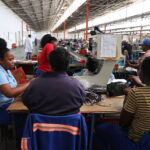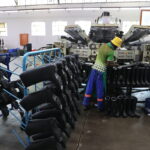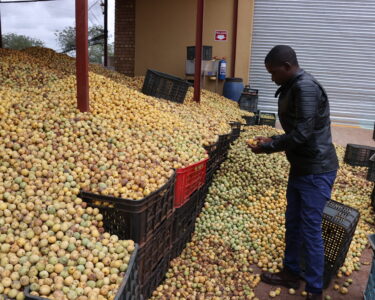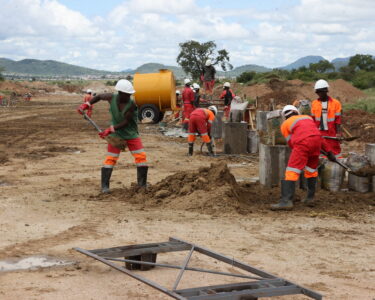There was a time when not buying your mother Tommy canvas shoes manufactured by Bata was deemed a “crime” and wearing the company’s Toughees was the in-thing for “scholars”. For the young-at-heart ladies, slip-on Sandak sandals were the obvious choice for a casual stroll around the hood. Those were the days when Bata was Bata.
When the economy was hit by the illegal sanctions imposed on Zimbabwe by the West, Bata Shoe Company felt the pinch as sales slumped to an all-time low. For years, Bata was on the brink of closing shop, but during a recent visit to Gweru, our Editor-in-Chief Munyaradzi Huni was in for a surprise. Not only is the company on the rebound, but has plans to dominate the footwear manufacturing and retailing market in Southern Africa.
Simon Mutisya is Bata Zimbabwe’s managing director and has been in the country for close to four years now. He insists both he – and the company he heads – are going nowhere anytime soon. “I have seen all the ups and downs in Zimbabwe and what I can tell you for sure is that Bata Zimbabwe is not going anywhere. We are here to stay,” he says, as he proceeds to give a comprehensive history of the company.
Said Mutisya: “Bata is mainly a footwear manufacturing and retailing company. With operations in more than 70 countries across the world, it is a global company headquartered in Switzerland. In Africa, we are represented in seven markets, i.e. Zimbabwe, Kenya, Zambia, Malawi, South Africa, Uganda and Botswana. The Africa head office is based in South Africa.
“We have been doing business in Zimbabwe for more than 80 years now. The first store opened its doors in Bulawayo, followed by Kwekwe and Gweru in that order. At the last count, Bata had 63 stores across the country, employing 1 300 people directly. We also employ another 200-250 people in associated business units. These are individuals running their own businesses to whom we sub-contact ancillary jobs, such as stitching, screening, etc.
“This is part of our corporate social responsibility programme under which we transfer skills and empower communities by introducing them to the shoe world. In addition, the company runs a chain of Bata Schools – a junior school with about 1 000 learners and the senior school with around 400 students. These schools are our signature projects. We also work with children’s homes in and around Gweru.”
“Bata has several factories based in Gweru, broken down as follows: Leather, canvas, plastic, tannery and the PU pouring technology section.
“From 2020 we started manufacturing gumboots in Gweru and these have been well received by the market. We have seen phenomenal growth in gumboot sales largely because Zimbabwe is mainly an agricultural and mining economy. We plan to invest in another gumboot machine in the next two to three years in response to growing demand.
“The PU pouring technology, which focuses on safety shoes, is going to be a game changer in shoe manufacturing not only in Zimbabwe but in the region. With the help of this technology, we should be able to supply our sister companies in the region with all their safety shoe needs.”
But why is Bata not going anywhere?
Zimbabwe may be facing challenges on the economic front, but these are far outweighed by the advantages, according to Mutisya.
“Bata Shoe Company is still in Zimbabwe because the country has all the key raw materials required to produce different kinds of footwear. Take leather shoes, for example. We source 100% of our raw hides from here which are then processed at our Gweru tannery plant.
“The same with the canvas shoes. Here, we are consuming textiles that are 100% Zimbabwe-manufactured, the major supplier being Kadoma Textiles, who have been our partners for ages. Bata is easily one of the major players in [the implementation of] NDS1 [National Development Strategy 1] in terms of the cotton and animal husbandry value chains.
“We are working to modernise the Gweru plant in order to turn Zimbabwe into one of our key manufacturing hubs as heading into 2025 and beyond. Zimbabwe has a number of obvious advantages. For one, it is centrally located, a blessing in terms of logistics. Secondly, since our target market is Sadc [Southern African Development Community], duties will not be a big issue. We are also serving Comesa [Economic Community of Eastern and Southern States] through Uganda and Kenya.
“There are concerted efforts by the top management to look at Zimbabwe from a long-term perspective. This is evidenced by the support we have received in terms of modernising the factory. I think we have, in the last five years alone, invested over US$3 million into refurbishing some of our operations, retooling the factory and improving our competitiveness in terms of productivity, efficiency and quality. This is in line with our desire to be competitive in the region.
“Bata is the only company using the vulcanised process, which we think gives us a competitive advantage in the supply of footwear to the market in both the Sadc and Comesa regions.
“We are also working with the Standards Association of Zimbabw (SAZ) towards achieving ISO 9001 certification. The process started in 2020, but was subsequently disrupted by the Covid pandemic. However, we expect to be ISO certified by the end of the year to be able to guarantee shoes of the highest quality to all our consumers.
“In terms of capacity utilisation, we have fallen short of our target. We are capable of producing 5,5 million pairs of shoes per annum, but we are currently at around 2,3 million pairs, which equates to approximately 40-50% capacity utilisation.”
The operational challenges and the solutions
Mutisya blamed the low capacity utilisation on several challenges, among them low disposable incomes, influx of cheap imported shoes, liquidity crunch. Says the Bata boss: “Our consumers are quite price sensitive given the pressures of other expenses such as health, housing, education, etc. Shoes are at the bottom of the pyramid. So we are not able to off-load the volumes that we would want. But this challenge is not unique to Zimbabwe. Even our export market has been similarly hard hit. To put it in a nutshell, we are more or less operating on a break-even basis. Going forward, we are trying to identify our major cost drivers and finding ways to cut costs as much as possible to make our footwear more competitive across the board.
“Secondly, there is an influx of cheap imported footwear. It’s bad enough that we have to put up with this kind of competition; it’s worse when the shoes are being sold outside our Bata stores. Don’t get me wrong, we are not scared of competition, but it should be fair. The importers must pay the mandatory duties and taxes. Let them display their wares at designated marketplaces rather than in front of our stores. They should not take advantage of our prime locations since we have invested a fortune in those stores in terms of time and money. And, don’t forget, we also have certain minimum standards to maintain.
“We are paying our council rates diligently, in addition to all the statutory taxes. All we are asking for is a level playing field, not protectionism or favouritism. We should not have vendors selling their wares in front of our stores. Simple.”
The worst hit were the Bata factories manufacturing canvas and patapata [flip-flops], said Mutisya. “Bata used to sell 800 000 pairs of patatapa per annum, but sales are now down to 300 000 pairs. This is because vendors are selling identical products outside our shops. So we need regulatory support from the authorities because the consumer must be the ultimate winner,” noted the Bata boss, who cited pricing as another thorn in the flesh.
Said Mutisya: “While some companies are flagrantly pricing their goods at the parallel market rate, we are obliged to use the official rate. This has implications on our export prices, too, rendering them uncompetitive. This takes away the incentive to export thereby reducing our competitiveness. I don’t know how this anomaly can be addressed. What I know for sure is that it is affecting our business negatively since I am reluctant to pass the extra cost on to the consumer.
“We have challenges, too, in terms of accessing forex, but we are ok, thanks to the Reserve Bank of Zimbabwe (RBZ) weekly auction. We were able to secure the US$3 million we required for refurbishment without much hassle. As we speak, Bata Zimbabwe has no outstanding bids on the auction market. In the long term, we could possibly generate our own generate forex needs from the sale of shoes, but at the moment this amounts to a measly 10%. This, in itself, is quite a challenge because,e just recently, Zesa sent us our electricity bill in forex. We can’t go to the auction floor to buy US dollars simply to pay Zesa.
“There is need to start looking at businesses like ours in terms of concessions. Can we, for example, be allowed to sell some of our footwear in US dollars only? Or can some of our stores be allowed to sell in forex only? The authorities must come to our rescue.”
Big things are happening in Zimbabwe
According to Mutisya, Bata Zimbabwe has plans to expand and form synergies with its sister companies in the region. “We already have a programme called Stepping Forward that is being spearheaded from our head office in Switzerland. This programme is looking at how we can grow Bata in the countries we are operating in and how we can leverage within the same market. For example, if it’s Africa, what are Zimbabwe’s strengths that can serve the other Bata companies within the region?
“There are some people who say things are not happening in Zimbabwe and I think they do not have their facts right. Maybe they are basing their argument on pre-independence history. It’s good to read this economy in the context of what is happening around the world. If you look at the Zimbabwean economy, then read it together with the Nigeria economy, with Egypt or any other country.
“For Bata, we might say the Zimbabwean economy has unique challenges. But to us the basic questions are — do we have customers that want to be served in Zimbabwe? There are there. Do we have the necessary manpower in Zimbabwe to meet our various job needs? Yes! Do we have the raw materials? The answer is yes. It’s up to the businessman to find a solution and how to steer the ship through those challenges. We could relocate to a different country, yes, but you will still find a new set of challenges there,” observed Mutisya.
Despite the challenges, real or imagined, Bata Zimbabwe was actually looking forward to opening new stores. “We have already budgeted for two additional stores,” said Mutisya. “We are still putting money into the factory. Yes, Zimbabwe has its fair share of challenges, but they are not unique to us. Every country has its own challenges. All it takes is a never-say-die spirit and the ability to identify what is good for you.”
Beyond borders, Bata plans to open more factories and shops in Egypt, Nigeria, Ghana, DRC and Dubai.
An appeal and request to the President
Mutisya ended our long discussion with a passionate appeal to President Mnangagwa:
“Please buy from Bata! Remind him. He knows it. Is government buying from us? Is there a market for military shoes? Is there a market for gumboots in our hospitals? Are the nurses wearing shoes? There is the Police. There is Prisons. There is the Military. Where are they getting their shoes from? Remind the President because we have discussed this before.
“My other request to government is that duty is not enough. We also need to protect our consumers [from sub-standard products]. There should be minimum standards for all imported goods, which clearly stipulate the minimum specs for leather shoes, canvas shoes and plastic shoes. Increasing customs duties is not enough. Quality also matters.”
Come rain or sunshine, it looks like Bata’s glory days will soon be back. Let’s get ready to buy our mothers – and grandmothers — more Tommies!








